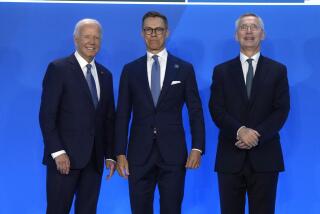Pushing the Nuclear Button : In Ultimate Crisis, Vice President’s Actions Count Most
- Share via
In discussing the choice before the voters, politicians and commentators often assert that only a President can “push the nuclear button.” Were that really so, the nation could be readily disarmed by a first strike. The chain of command must be free of that vulnerability, and under most circumstances it must also allow the President to be visible to the world. These two requirements imply that others must be able to “push the button,” even in situations where the President is still alive but isolated. In particular, it is quite likely that the vice president would command U.S. forces in the wake of a missile attack.
The vulnerability of any fixed target to nuclear attack has led to separate peacetime and wartime command systems adapted to the very different environments in which they would be used.
In peacetime, orders from the White House are transmitted to the forces via the Pentagon. Both of these facilities are “soft”--they would be vaporized by the smallest nuclear attack. Should any appreciable risk of a missile strike arise, however, a mobile system, which cannot be targeted from afar, would be swiftly activated. At this time its most vital elements would be a fleet of aircraft for all principal commands. The apex of this system is the National Emergency Airborne Command Post, nicknamed Kneecap.
From their observation of Presidents in action, many Americans who have held very senior national-security posts have concluded that a President probably would insist on staying in Washington in a severe crisis, even if it threatened to culminate in a Soviet missile attack on the United States. They argue that, given our society, it would be very difficult for a President to leave Washington without detection. And if he did leave, that could be interpreted by Moscow as an ominous indication that the United States was about to attack, and might thereby trigger a preemptive Soviet strike. Finally, there could be crippling panic here and among our allies if it became known that the President had abandoned his capital.
Even in this time of glasnost, the Soviet government does not suffer from this predicament. The general secretary has disappeared to unknown parts for weeks on end. The top layer of the Kremlin could be evacuated without the severe penalties that the corresponding U.S. action would entail.
Experts agree that the most viable arrangement for coping with the U.S. dilemma would be to leave the President in Washington and covertly move the vice president and his senior advisers to Kneecap or some other secure command post. This would leave the President both visibly and actually in command for as long as possible. If he were killed or isolated, his legal successor--and the only other person who enjoys the legitimacy of having been elected nationally--would be ready and able to take command.
While there is a consensus that a Soviet missile attack is a remote contingency, fear of a first strike continues to drive much of the debate about strategic forces. In the event of a first strike, nearby Soviet submarines could hit Washington and other key points in the command system without giving enough warning to permit evacuation of the President. Even an attack that was not targeted at the Washington area could, by design or inadvertence, cut communications from the President to the nuclear forces and require the vice president to assume the role of commander in chief.
Our country’s first vice president, John Adams, called the office “the most insignificant . . . that ever the invention of man contrived or his imagination conceived.” When cannon balls fired from sailing ships constituted the “time-urgent” threat, that may have been an amusing exaggeration. In an era of the nuclear-armed intercontinental missile, however, the vice president could suddenly become the nation’s key decision-maker at the most fateful moment ever faced by mankind.
More to Read
Get the L.A. Times Politics newsletter
Deeply reported insights into legislation, politics and policy from Sacramento, Washington and beyond. In your inbox twice per week.
You may occasionally receive promotional content from the Los Angeles Times.









